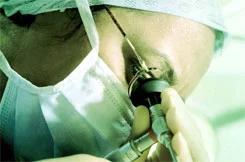Keyhole medicine and turbine inspections
The tip is occupied by the camera, hidden in the endoscope’s shaft. Designed by the Adlershof company MGB Endoskopische Geräte GmbH Berlin to help doctors gain a better view in the abdominal cavity the device presents a plain appearance: A long shaft ending in a handle from which two cables lead. Yet inside there is hitech in the minimum of space.
Whereas on conventional endoscopes the camera is installed as an external component with a remote video sensor and the distance between has to be bridged with a system of up to sixty lenses, the camera in this new development has been moved to the very tip. “We can save fifty lenses, and of course the lens defects as well that lead to blurring or distortion in the image. The image has a greater depth of definition and looks more natural”, explained Johannes Tschepe, Managing Director of MGB, when asked about the advantages of this new layout. This first became possible after the camera had been miniaturised. Making good progress with ever smaller technologies – here is the opportunity for microsystems engineering. The sector is booming, and according to the report for the sector issued by the Berlin Technology Foundation TSB the turnover of the approximately 170 companies operating in Berlin grew by 56 percent between 2002 and 2007. MGB is selling its Videolux endoscope above all in Asien: “We’re especially successful in China. There it’s used by the modern and extremely well equipped hospitals of the People’s Army.” The endoscopic devices from Adlershof not only open up views into sealed spaces for so called keyhole medicine.
They also for example allow inspections inside technical installations, like power plant turbines. And here too use is made of miniaturised hitech in the form of a micromotor that is arranged directly around the lens. This new component can be used to expand the functions of industrial endoscopes, for instance with autofocus or improved zoom options.
Sharper images are also the concern of the Adlershof company LensWista, which utilises extremely miniaturised technology to produce new kinds of contact lenses. The head of the company Alexey Kalachev has developed a method that can alter the surface of his pure silicon lenses on the nano scale. Consequently the lenses can remain on the eyes for up to three months continuously. Applications are presently in the test phase.
Dr. Tina Heidborn
